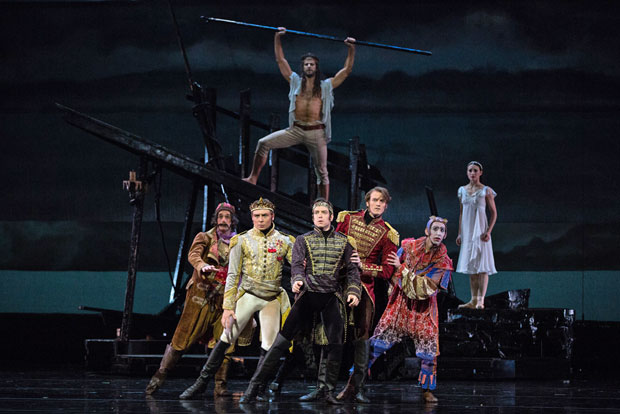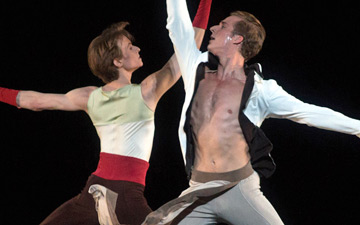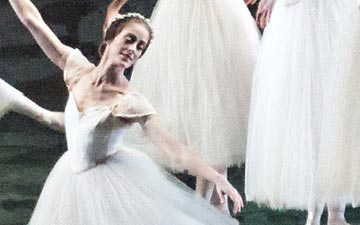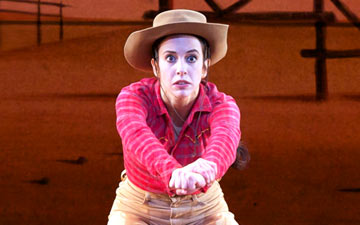
© Marty Sohl. (Click image for larger version)
American Ballet Theatre
Opening Night Gala: Tempest, Theme and Variations, Pièce d’Occasion
New York, David H. Koch Theater
30 October 2013
www.abt.org
Spirits to Enforce, Art to Enchant
It’s been a season of flashy new story ballets in New York. First, there was Matthew Bourne’s Sleeping Beauty, in which the fairies – usually so gentle and sweet – turned out to be toothy vampires. Then came Christopher Wheeldon’s Cinderella for San Francisco Ballet, a production full of eye-catching stage effects, most dramatically the sudden appearance of a horse-drawn carriage assembled out of little more than billowing fabric and human bodies. (This feat of illusionism was orchestrated by the puppeteer Basil Twist). And now, on Oct. 30, we had the unveiling of the centerpiece of American Ballet Theatre’s fall season: Alexei Ratmansky’s new Tempest. The première took place at the company gala, held at the former New York State Theatre, decked out in decadently eerie style. The company last performed there in the seventies. The program, short and sweet, was completed by Balanchine’s 1947 Theme and Variations (with new costumes by Zach Brown), and a short amuse bouche for eight men, composed for the occasion by company dancer Marcelo Gomes.
Fashioning a ballet out of The Tempest is no small endeavor. How does one distill Shakespeare’s rather complex play into forty-six wordless minutes, using Jean Sibelius’s incidental music as a guide? The task was deemed complicated enough to warrant the help of an experienced dramaturge, Mark Limos. Shakespeare’s comedy has more than a dozen characters, some of them supernatural, all with interconnected back-stories. This number has been pared down by Ratmansky and Lamos to a still-substantial ten. (Remarkably, all but one of the main roles is played by men. It’s a sort of Sylphides in reverse.) As in Midsummer Night’s Dream, the characters have a tendency to wander off and become embroiled in their own private dramas. It’s a lot to keep track of. Crystal Pite, who recently created a version, resorted to supertitles and projections; to be doubly sure we got it, she told the whole story twice.
The temporal element is also tricky. By the time the curtain rises, several crucial events have already occurred. Most important of these is the betrayal, overthrow, and banishment of the central character, Prospero, Duke of Milan, along with his daughter Miranda. Therein lie many of the underlying motivations of the play. Ratmansky refers to this coup through an effectively spare, dream-like flashback, with Sascha Radetsky as a deceitful Antonio, usurper of his brother’s throne. Prospero (Marcelo Gomes) distractedly lays aside his crown as he reads one of his many books; Radetsky swoops in and places the crown on his own head. As the figures slowly melt down to the stage, they once again become the castaways, slumbering on the shore. Past elegantly merges into present.
In general, though, Ratmansky has avoided mime, a tool he has used to brilliant effect in the past (as in The Bright Stream). Instead, he has chosen to rely on pure movement to illustrate the story. The characters dance their states of mind. As the note in the program points out, “the ballet is at once a fragmented narrative as well as a meditation on some of the themes of Shakespeare’s play.” It is both those things, but even more, it is a series of psychological portraits of its central characters. Each (Miranda, Ariel, Caliban, Ferdinand) dances a kind of aria. Most also have a duet with Prospero; he is the hub of the play’s network of relationships. Some characters come alive. We are captivated by the strange and slithering Caliban (Herman Cornejo) and his counterpart, the silvery, airy Ariel (Daniil Simkin). But Prospero eludes us; it is as if Ratmansky hasn’t quite decided who, or what, he is, or, more importantly, what he feels. The choreography for Prospero is blurry, contradictory. Miranda (Sarah Lane) too is a cipher, a one-dimensional type: pretty, vulnerable, and soon enough, in love. The object of her affections, handsome Ferdinand – a breakout role for Joseph Gorak, he of the gorgeous arabesque – makes more of an impact. The two dance a playful, almost child-like pas de deux, skipping and skittering side by side, playing tag, quickly falling under each other’s spell. There’s a lovely lift in which he picks her up gingerly by her shoulders, as if afraid to harm her. Ratmansky calls forth a boyish vulnerability in the normally cool Gorak. It’s a quality I’ve never noticed in this dancer before. Gorak may well have a romantic prince lurking inside of him after all.

© Marty Sohl. (Click image for larger version)
Sibelius’s music is both a help and a hindrance. The Finnish composer wrote these pieces in 1926, relatively late in life, at the invitation of the Royal Theatre in Copenhagen. They were meant to be played as incidental music accompanying a production of the play. The sections, with titles like “The Storm” and “Caliban’s Song,” are imagistic and atmospheric, like a series of tone poems, or, as Ratmansky said to the Times, “illustrations in a book.” But, evocative as they are, they were not written to carry the plot or to be danced to. Sibelius’s orchestration, heavy with harp, harmonium, and dream-like harmonies for chorus, creates a fantastic landscape of sea, mist, and supernatural creatures. But for the most part, the music doesn’t contain the impulse to action. Nor does it lead anywhere in particular. Ratmansky has had to carve out the episodes he wants to tell, sometimes battling the music’s tendency toward stasis. (Curiously, the same is true of Nico Muhly’s music for Two Boys, over at the Metropolitan Opera. Writing music that moves the plot is a very specific skill.)
Ratmansky’s tendency is to treat each scene independently, at the expense of continuity and momentum. In contrast, consider Frederick Ashton’s The Dream. By focusing on a small sliver of the story, Ashton – a master storyteller – managed to be both extremely detailed and also to build steadily toward the story’s happy resolution. “How will they get out of this mess?,” one wonders, every time. Ratmansky’s Tempest lacks precisely this tension. One scene does not lead inevitably into the next, and we lose track of the arc of the characters’ fate. Why get bogged down, for example, in a confusing scene in which drunken Trinculo, a secondary character, repeatedly tries to crawl under Caliban’s cloak to get out of the rain?
The ballet begins with a mighty storm that carries the ship bearing most of the play’s characters to Prospero’s island. There, Prospero awaits, with his servant Ariel, a spirit. The ship is a hulking ruin – designs are by Santo Loquasto – of indeterminate shape that later serves as a one-size-fits-all set piece. On opening night the role of Ariel was danced by the light, fleet-footed Daniil Simkin, almost unrecognizable under his bluish makeup, spiky red wig, and spandex. In general, the costumes are rather heavy-handed. Prospero, with his bare chest, artful rags, and long, scraggly wig tied back by a headband, looks more like a bearded hippie than a sorcerer. But that’s nothing compared to Caliban – Herman Cornejo – whose body is covered with patches of hair, above which sprouts an enormous afro, his face heavily made up, with clown-like eyes. Ratmansky has avoided the prettified esthetic of most fairy-tale ballets, but at times the storytelling is overwhelmed, even engulfed, by the costumes. The corps, depicting island spirits, wears spiky cellophane mohawks and belted tunics out of Lord of the Rings. It’s all a bit much. On the other hand, the designs for the sky and sea, diaphanous lengths of silk bathed in shifting colors of light, by Robert Wierzel, are ravishing.
Unlike other Ratmansky ballets – again, The Bright Stream comes to mind – the dancing does not always support the characterizations. At times, the steps become mired in complexity and accumulation. The character of Prospero, especially, remains ill-defined; for the most part, he reacts and consoles. Unsurprisingly, the most effective choreography goes to Ariel and Caliban. Like Puck in Midsummer, Ariel is all brilliance; he jumps from one foot to the other, launches into fluttering, exaggerated beaten steps, and suddenly swoops down to the floor from a turn. The most striking step in the ballet is his soaring leap, chest lifted to the sky, head thrown back. Ariel’s nervous fluttering – so suited to Simkin’s technique–is a physical manifestation of his hunger for freedom. His pleading with Prospero for release from servitude is a central theme of both the play and the ballet. One senses that Ratmansky sees this struggle as an echo of Prospero’s own inner turmoil.
Ratmansky’s Caliban is more enigmatic. At first, he slithers and crawls, his hands and arms brushing the floor. Later, he performs comical pratfalls and acrobatics (see above, the scene with the cloak). But the choreographer can’t resist unleashing Cornejo’s gifts in an exciting display of fireworks worthy of the noblest prince: jumps over one leg, sissonnes, agile springing jumps that go straight up into the air with legs bent, barrel jumps. (In traditional ballet terms, his character is half “character,” half “noble,” an intriguing mix.) His final solo is a lament. The others board their ship, eager to return to the civilized world, with barely a look back. Caliban is left alone on the island. The anguish of the outsider, struggling against his own nature and the order of things, is a theme close to Ratmansky’s heart, one that returns in ballet after ballet. The final moment of The Tempest is the most poignant: Caliban crawls over to Prospero’s book of spells, touches its binding, and then begins to tear out its pages. He’s monster, but he has a soul, tormented as it is.
More generally, what works best in this Tempest is the choreographer’s way of hinting at relationships between the characters. We see Prospero’s overbearing protectiveness of Miranda and her intimidated love for him; Caliban’s repulsion and attraction toward his master; Ariel’s rebellion against an authority he cannot openly defy. (In many ways, Ariel is like a teenager.) We see, too, Alonso’s heart breaking as he realizes that his son Ferdinand is probably dead. In this small scene, Roman Zhurbin, the company’s most compelling actor, could have made a stone cry. It’s clear that these relationships are what matter most to Ratmansky. But their hold on our attention is intermittent. There have been other versions of The Tempest beginning in the nineteenth century, most notably Glenn Tetley’s from 1979 (with a score by the Norwegian composer Arne Nordheim). More recently, there was Crystal Pite’s Tempest Replica and an opera by Thomas Adès. I’ve seen the Pite and the Adès. Neither revealed anything essential about the play. On first viewing, my sense is that Ratmansky’s falls short as well. Perhaps The Tempest is not really translatable. At the least, it probably needed a more severe edit.
As mentioned, the evening opened with a performance of a newly-spruced-up Theme and Variations, with Gillian Murphy and James Whiteside in the principal roles. The revamped costumes, in attractive shades of gold, peach, and brick, have a suitably magnificent Russian feel. Murphy and Whiteside gave an energetic, articulate rendition of Balanchine’s crystalline choreography, all contrasts of direction and dramatic, un-embellished shifts of weight. Whiteside, perhaps battling nerves – it’s a notoriously difficult ballet and he’s just been promoted to principal – seemed a touch breathless. But, as a friend said at intermission, “he’s got the right idea.” Murphy attacked the steps with her usual verve and natural, unemphatic grandeur. Generally, the ensembles could be a bit sharper in the allegro parts, and more generous and plush in Tchaikovsky’s slow, almost holy passages. Some of the poetry, the higher spiritual dimension of the ballet, was missing at this performance. (The dancers may simply need to perform it a few more times.) After a short pause, Theme was followed by Gomes’s Aftereffect, a romp for eight shirtless boys, led by the brash, virile Sascha Radetsky. The men stomped, skated, lunged, and leaped across the stage to the first movement of the turbulent but overused Tchaikovsky sextet Souvenir de Florence. The men lifted and propelled each other, something we see more and more often in ballet. The piece was less coherent than energetic, but it had the virtue of displaying the company’s impressive roster of men, including the blossoming Calvin Royal – showing off finely-etched, elastic transitions – and a new member of the corps, Zhiyao Zhang. In one of several climaxes, Zhang launched into an endless series of beautiful spinning jumps as the other guys egged him on. What’s not to love?
The fall season, which includes revivals of Les Sylphides and Mark Morris’s Gong as well as a reconstruction of Twyla Tharp’s 1983 work, Bach Partita, (last seen in 1985), continues through Nov. 10.

















[…] Anyway, the program consisted of of three works: Balanchine’s Theme and Variations, The Tempest, and a trifle by Marcelo Gomes. Here’s my review for DanceTabs. […]
Dear Marina,
Thank you for the review. It will be interesting to attend after reading your opinion.
I hope that you are well.
Best,
Barbara Thau